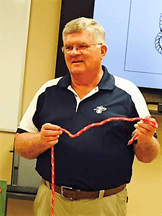Then The Knot Slipped . . .
As simple as it seems, being able to use and tie the right knot can be the difference between life and death in an emergency.
This week we hear from an EmergencyPlanGuide.org reader about a recent CERT training class he led.
A SKILL WORTH KNOWING — by Sparky Wilson

CERT members practice knot tying
Many skills learned by Community Emergency Response Team (CERT) volunteers can come together to make a huge difference in the success of a disaster response. The Lee County, North Carolina CERT actively studies and practices those things we learned in the CERT Basic Course: individual preparedness, basic first aid, light search and rescue, light fire suppression, disaster psychology, CERT organization, effective radio communications, etc. Those are all very important; but, there’s one important skill we have neglected until now – knot tying.
WHY KNOT?
Well, learning how to tie knots can save lives. We all know that anyone can tie a knot; but, that is not the solution. Knowing how to tie the right knot for the specific need is the solution. There are dozens of different knots with hundreds of uses and all knots are not good for all purposes.
We began our knot tying efforts by studying different knots to determine those our team members would find most useful in an emergency. As an added benefit we are finding that these same knots can make life a little easier around the house.
CERT VOLUNTEERS TIE KNOTS?
It is critical that we stay within the CERT scope of work. We will never be first responders trained in the use of ropes and knots and that’s okay. Staying within the CERT scope of work we feel that there are emergency situations where with the use of a few simple knots CERT volunteers can help their neighbors in trouble until the professionals arrive.
None of us want to think about a hurricane, tornado, earthquake, flooding, or any other major disaster hitting our neighborhood. Unfortunately, hope is not a method and not preparing for likely disasters just won’t work.
Assume for a minute that a disaster hits your neighborhood – homes are damaged, residents are hurt, communications are down and you can’t reach the professional responders for help. So what can do you do? You can activate your CERT team and start your response efforts.
Your search and rescue team deploys and discovers victims – some trapped under heavy objects. You start extricating trapped victims and look for loose items overhead and around the scene that can possibly fall on to your team and/or the victim.
- Can you secure these items with rope and knots to keep them from falling while you extricate the victim?
- Can you fashion the right knot on the end of a rope and toss it to the victim allowing rescuers to stay safe and accomplish the mission?
- What is the best knot to use?
- Do you know how to tie a Bowline or a Figure Eight Loop?

Good for rescue loops at the end of a rope – the Bowline and Figure 8 Loop
You’ve extricated the victims and you set out to move them to the Medical Treatment Area. You quickly discover that the roads are blocked with fallen trees and debris.
- What knot should you use to move fallen limbs and logs?
- Do you know how to tie a Timber Hitch knot? (The far right-hand photo at the top of this page.)
LEARNING TO TIE KNOTS ADDS TO OUR PREPAREDNESS SKILL SET
We built Knot Tying Stations and held our first training class on the use of knots in June. Our team members were oriented on how and when to tie ten useful knots that can save lives. Our “hands-on” training included tying and learning the best uses for the following knots: Overhand, Figure Eight knot and Loop, Square, Sheet Bend and Double Sheet Bend, Round Turn with Half Hitches, Clove Hitch, Timber Hitch, and the King of all Knots, the Bowline. As a memory jogger, every team member was issued a two page instruction sheet that pictures and describes how to tie each of these knots and when to use the most important knots. These instruction sheets are to be carried in our CERT backpacks.
PRACTICE, PRACTICE, PRACTICE
Sailors, rock climbers, firemen, and boy scouts will tell you that tying a knot is one thing, but tying it properly is another. Our team members are no longer strangers to a few good knots. We will master these knots by incorporating additional knot tying sessions into future training plans. After all, practice makes perfect.

Sincere thanks to our guest author, Sparky Wilson! He is a retired Army Colonel living in Carolina Trace, NC. In 2006 Sparky started a local CERT group and over two hundred volunteers have completed the CERT Basic Course since then.
Do you have a volunteer group story to share? I’d love to feature you in one of our Advisories — just drop me a line and let me know! In the meanwhile, don’t let summer lull you into complacency. Preparedness is a year-round exercise!
Virginia
Your Emergency Plan Guide Team
P.S. If you are intrigued by rope tying, or have experienced first hand just how effective a few good knots can be and want to learn more, take the time to study both how to tie the knots and understand their weaknesses. Some knots slip if not under constant pressure. Some can tangle if they are under too much pressure. Select the right rope and the right knot for the job and this is a skill you’ll appreciate on a regular basis, not just when there’s an emergency.
